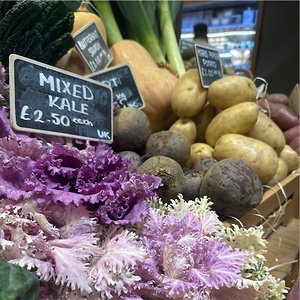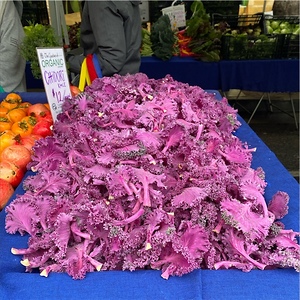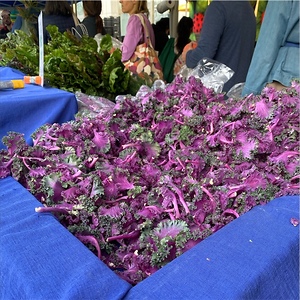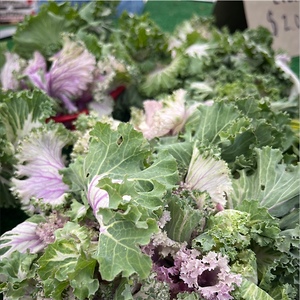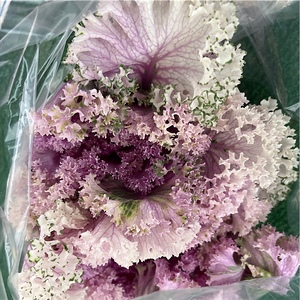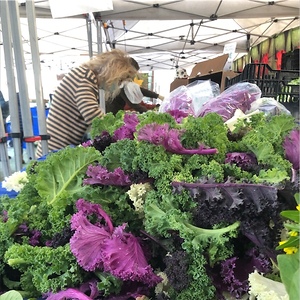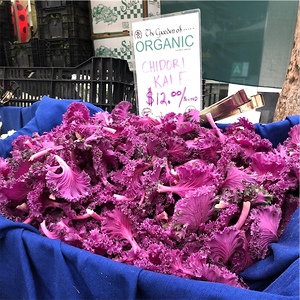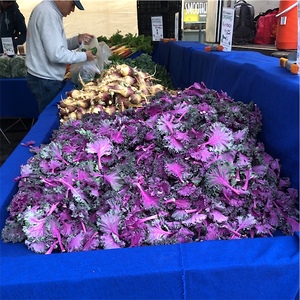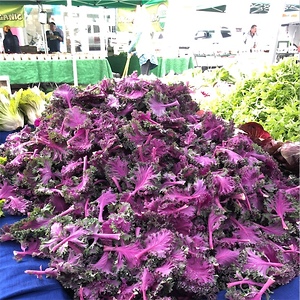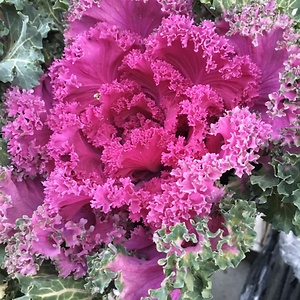


Chidori Kale
Estimated Inventory, bunch : 0
Description/Taste
Chidori kale is a compact variety that forms tightly layered, open rosettes. The rosettes vary in size, depending on the growing environment and maturity, and it is common to see the rosettes broken apart into leaves when sold for culinary purposes in fresh markets. The leaves are curly, heavily textured, and have a broad center with frilled edges. Chidori kale leaves appear in variegated shades of dark green, pink, purple, white, and red, varying with climate and cultivation environment. The exterior leaves showcase a muted, blue-green hue, while the center leaves in the rosette display white or saturated, red pigmented greens. Each leaf may also have varying shades, with the veins and stems typically contrasting with the leafy portions. Chidori kale has a chewy and crisp consistency when raw. Young leaves will have a more tender, succulent nature and are generally preferred for culinary use over mature greens. Chidori kale has a mild, neutral, green, and cabbage-like taste with subtly earthy, bitter, and grassy nuances.
Seasons/Availability
Chidori kale is available year-round, with a peak season in the winter through early spring.
Current Facts
Chidori kale, botanically classified as Brassica oleracea var. acephala, is an ornamental kale belonging to the Brassicaceae family. The cultivar is known for its large rosette of colorful leaves and can reach up to thirty-five centimeters in height. Chidori kale is a general name for two varieties encompassed in a series. Chidori Red kale has magenta to red flushed leaves, while Chidori White kale rosettes have a bright white interior. Both types have interchangeable uses and can be harvested at any maturity stage, depending on preference. Chidori kale is mainly known as an ornamental variety grown for its appearance rather than flavor. The variety develops vibrant, pigmented leaves through periods of cold weather and is a hardy, easy-to-grow plant. Beyond its ornamental use, some growers cultivate the variety as a specialty culinary green. Chidori kale is typically sold in its baby stage for culinary purposes as the leaves have a milder flavor and more tender, succulent consistency. Chidori kale is sought by chefs and home cooks for its unique coloring and versatility in raw and cooked culinary preparations.
Nutritional Value
Chidori kale has not been extensively studied for its nutritional properties. The leaves’ red and purple hues indicate the presence of anthocyanins, natural pigments with antioxidant properties to reduce inflammation and support overall bodily health. Kale, in general, is a source of fiber and minerals to regulate the digestive tract, and vitamins A, C, E, and K to aid in faster wound healing, maintain healthy organs, and guard cells against free radical damage. Kale also provides minerals like iron, magnesium, phosphorus, calcium, potassium, and zinc. Iron develops the protein hemoglobin for oxygen transport through the bloodstream, magnesium controls nerve functions, while phosphorus and calcium support bone and teeth health. Potassium balances fluid levels within the body, and zinc helps the body fight off infections.
Applications
Chidori kale has a mild, green, and subtly bitter taste suited for fresh and cooked preparations. The variety is primarily sourced for culinary purposes when the leaves are young and tender. Young Chidori kale can be trimmed to remove tough portions and tossed into salads or used as a decorative garnish and underlay. Both white and red Chidori kale types can be used interchangeably in recipes and add visual appeal when mixed in preparations. Try adding Chidori kale to sandwiches or grain bowls for a pop of color. The greens can also be blanched and combined with aromatics as a simple side or added to stir-fries. Chidori kale is commonly sold through farmers’ markets and is recommended to be baked like a crisp chip or added to soups and stews. Some coloring may be lost during cooking, but red Chidori typically darkens in color after heating. Chidori kale can also be combined with legumes or utilized in steamed, sautéed, or braised preparations. It is important to note that Chidori kale should never be foraged from public areas or garden centers without extensive background research. Many ornamental varieties are not grown organically and may have been sprayed with pesticides or herbicides. Only consume Chidori kale that has been grown naturally and without harmful chemicals. Chidori kale pairs well with nuts like almonds, pine, and peanuts, aromatics including ginger, shallots, and garlic, and herbs such as thyme, basil, and parsley. Whole, unwashed heads will keep for a few days to weeks when stored in the refrigerator.
Ethnic/Cultural Info
Chidori is a Japanese name for a small bird. In Kanji, Chidori is comprised of “chi,” meaning “a thousand,” and “dori,” translating to “birds.” While there are several translation theories, the most common has the word Chidori referencing a wading bird known as a plover. In Japan, plovers appear at the end of the rainy season and often congregate in large groupings along shorelines. Plovers symbolize longevity, determination, and courage, and the tiny birds face challenging weather patterns and waves throughout their life. This notion of longevity and endurance is applied to Chidori kale as the variety is hardy and easy to grow. Some sources also note that the name Chidori may reference the variety’s contrasting textural leaf elements between flat and deeply frilled, with the wavy edges embodying the birds.
Geography/History
Chidori kale is thought to have descended from ornamental kale varieties developed in Japan. Much of the variety’s history is unknown. Ornamental kale, in general, is derived from wild types of Brassica oleracea native to the Mediterranean and the Middle East. The Greeks and Romans domesticated early forms of kale, and in the 4th century, various types were introduced to China through trade. Kale was quickly established in China as a culinary and medicinal ingredient, and the plants eventually made their way to Japan, where they were bred for their colorful, ornamental foliage. These varieties of kale later became known as ornamental kale and became a favored plant for home gardens throughout Japan. In 1929, plant explorer and horticulturalist Palemon Howard Dorsett was sent by the United States Department of Agriculture to China and Japan to search for new plant species. During his time in Japan, he selected several types of ornamental kale for introduction into the United States. Ornamental kale appeared in American seed catalogs in the 1930s, and since its arrival, it has evolved into a versatile plant for decorative and culinary purposes. Today, Chidori kale is cultivated as an ornamental and culinary ingredient worldwide. The cultivar is not commercially produced on a large scale for culinary use and is primarily found through specialty growers in fresh markets.
Podcast



